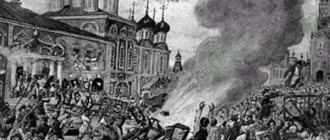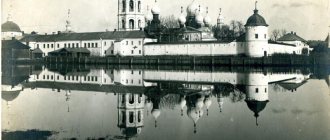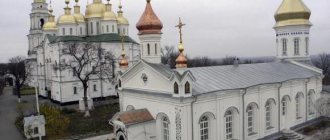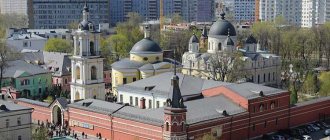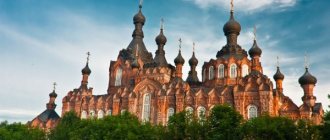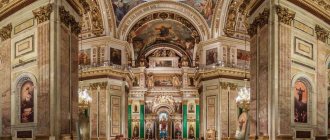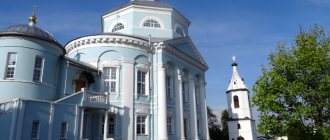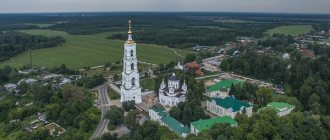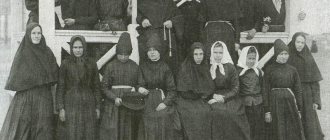| St. Petersburg Ioannovsky Monastery |
St. Petersburg St. John Convent on Karpovka
, a stauropegy of the Russian Orthodox Church within the boundaries of the St. Petersburg Diocese
- Address: Russia, 197022, St. Petersburg, embankment of the Karpovka River, 45
- Tel.
- Official site:
- On the map: Yandex.Map, Google map
The monastery was founded by Righteous John of Kronstadt at the beginning of the century.
Construction of the monastery began in the spring of 1900 according to the design of the architect N.N. Nikonov, which was approved by Emperor Nicholas II, on a small plot of land donated to Father John by the merchant Simeon Ramensky.
The building of the monastery church was consecrated on December 17, 1901. The lower church was consecrated in honor of St. John of Rila, the upper cathedral - in honor of the twelve apostles.
By determination of the Holy Synod in February 1903, the monastery was given independent status.
From the very beginning, Father John took special care of the improvement of the new monastery, and through his labors and prayers the monastery reached its peak. Here were his chambers, where he stayed during his visit to St. Petersburg. A temple-tomb was built here, in which, according to his will, he was buried on December 23, 1908. The tomb was consecrated in the name of the prophet Elijah and Queen Theodora, the heavenly patrons of the parents of Father John.
By 1917, 350 sisters lived in the monastery. The sisters did almost everything they needed themselves. The monastery had its own farmstead, workshops, and hospital. Charitable assistance was provided to those in need, and an orphanage was operated. During the First World War, an infirmary was opened in the monastery for wounded soldiers and officers.
The monastery was officially closed in 1924, all property was taken away and looted, and the building was transferred to the management of more than twenty different organizations. In subsequent years, almost all the sisters were arrested and sent to prisons and camps.
In 1989, the return of the monastery to the Russian Orthodox Church began. In the 70 years that have passed since the monastery was closed, the building has fallen into severe decline. The temples and all premises were rebuilt. It took several years of intensive repair and restoration work to return the monastery to its original appearance.
Simultaneously with the restoration of the walls, a revival of monastic life began.
On July 12, 1991, Patriarch of Moscow and All Rus' Alexy II consecrated the upper church.
On December 25, 1991, the Ioannovsky Convent became independent.
The monastery operates a Sunday school for children and conducts catechetical classes for adults. In the temple-tomb of Righteous John of Kronstadt, a small museum dedicated to St. John and the history of the monastery.
In 1992, the monastery received stauropegial status and is directly subordinate to the Patriarch of Moscow and All Rus'.
On July 12, 2015, by decree of Patriarch Kirill, the Cathedral of the Twelve Apostles of St. John’s Monastery was awarded the right to celebrate the Divine Liturgy there with the Royal Doors open according to the “Our Father” [1].
How to get there
Ioannovsky Convent on Karpovka is located in the central, historical part of the city, in the area popularly called “Petrogradka”. Getting here by car is not difficult. You can arrive from anywhere in St. Petersburg. The route will depend on where the trip starts. The monastery can also be reached by public transport.
The easiest way to get there is to use the metro. The monastery is located not far from the Petrogradskaya station.
You can walk from it. Walk to the monastery for about 10-15 minutes. Coming out of the metro, you need to turn right and walk along the avenue called Kamennoostrovsky. Having reached the Karpovka embankment, you need to cross the Silin Bridge, then turn left and walk along the embankment all the way to the monastery.
You can get there not only by metro, but also by other public transport:
- by tram number 340;
- by bus number 10;
- on minibus T234;
- by bus No. K 321;
- by bus number 25;
- by minibus K 98;
- by bus K 222.
Stops for this transport are located near the monastery, so it will be impossible to get lost.
Merits of Father John
The priest carried out many difficult ministries: he taught at a city school, a classical gymnasium, and organized houses of industriousness to help the poor. Through his efforts, 4 monastic convents, nurseries, shelters, and shelters for the homeless were formed. In the St. Petersburg diocese, through the efforts of the righteous man, 50 farmsteads were organized, dozens of churches were consecrated, and guardianship in the name of the Apostle Andrew the First-Called was established.
Become a courier of the Yandex.Food service right now (up to 3,400 rubles per shift) leave a request →
In the late 80s of the 19th century, the educator became widely known not only in his homeland, but also abroad. Thousands of prayer-bookers began to flock to Kronstadt, hoping to meet with the perspicacious priest. Up to 6 thousand people came to the cathedral for services.
The righteous man left behind a spiritual diary - an edifying, soul-helping work known as “My Life in Christ.” The first Russian revolution caused sharp criticism from the saint. Father John accused its organizers of godlessness.
- 1893 - becomes an honorary member of the Theological Academy (St. Petersburg).
- 1899 - awarded the title of mitred archpriest (the highest honor for married clergy).
- 1905 - received the Order of Alexander Nevsky, also had the Orders of St. Anna and St. Vladimir.
- 1906 - becomes a member of the Holy Synod.
Father passed away on January 2, 1909, he was 79 years old. The saint had been ill for a long time, and a whole crowd gathered in front of the house, waiting for news about his condition.
Story
Initially, the monastery was not built independently, but as a courtyard for another women's community. The construction site was consecrated in 1900. Construction began in the same year. In 1901, the main building of the complex was ready. The consecration of the lower temple took place immediately. It was decided to leave the monastery independent, and not as previously planned.
In 1902, the main temple, which occupies the 2nd and 3rd floors, was consecrated. From 1903 to 1908, construction of the monastery continued. Premises were built, which later formed an entire monastery complex. While construction was going on, John of Kronstatt contributed and helped. In 1908 he died and was buried in the basement of the main building.
Miracles of healing began to occur in the tomb. In 1909 alone there were more than 10 of them. In 1919, the monastery complex was captured by the Bolsheviks. They turned the monastery into a commune and opened a hostel there. The sisters lived there for another 3 years and then were evicted. They were soon arrested and deported to Kazakhstan.
In 1923, all the property of the monastery was confiscated. It was decided to liquidate the monastery. As a result, all buildings were transferred to the technical school. The entrance to the tomb of John of Kronstadt was walled up. The monastery complex was returned to the church only in 1989. At first it opened its doors as a courtyard of the Pukhtitsa monastery.
The entrance to the tomb of I. Kronstadt was bricked up. The first floor was vacated and again acquired the appearance of a temple. Renovations have begun throughout the complex. Soon the temple, located on the 1st floor, was consecrated and began to function. We managed to get it in order in just 2 weeks. The first service after restoration took place in November 1989.
The news that the monastery had been partially restored quickly spread, and a huge number of believers came to the first service. There were so many people that they could not all fit in the building. Many had to stay on the street. So that everyone could hear the progress of the service, speakers were installed that broadcast everything that was happening inside.
In 1991, the upper temple was also restored. In December of the same year, the monastery was declared stauropegial, that is, subordinate not to the local church authorities, but to the patriarch. Today the monastery has been completely restored and is functioning. Every day services are held here, and you can confess. On certain days the Sacrament of Baptism takes place. All-night vigils are held.
Miracles created by the founder
It is noteworthy that John of Kronstadt could perform miracles during his lifetime. He helped people more than once. One day a woman came to him for help, after he helped her and wanted to leave, she offered him money, but he didn’t take it. He said that he didn’t need them, and that she should give them the next day to the first person she met on the street.
The woman listened to him and the next day, getting up early in the morning, she went out into the street in the hope that she would meet a wretched man. But to her surprise, the first person she met was an officer. At first she did not dare to approach him and walked past. But remembering the words of the monk, she returned and caught up with the officer. After explaining everything to him, she gave him the money.
Dear brothers and sisters! We invite you to visit the unique resource https://www.slovo-pomoshi.ru/. With its help, you can convey your aspirations to St. Petersburg churches, chapels, monasteries, and also contact the righteous at the place of their burial. We will write a note ourselves, take it to the temple and send you a photo report by email. Turning to God with the help of prayers has helped many people overcome grief, regain health and the joy of worldly life.
Useful articles:
THERE WAS A MAN IN THE WORLD WHO DIDN'T BELIEVE IN GOD! There lived a man who did not believe in God and did not hesitate to tell everyone about his attitude towards religion and religious holidays. However, his wife believed in God and raised her children in the faith, despite her husband’s caustic attacks. One winter evening, the wife went with the children... Read more
A cat with a capital letter A cat lives for 3 years in a cemetery... I want many to read and think about what we do for our little brothers and what they do for us... I often go to visit my deceased ancestors at the local cemetery in the village of N. Today I’m on another I visited there once after winter. But I... Read more
Parable. When the Lord commands... A poor woman from a small family was very religious. And one day, when there was not enough money even to feed the children, she called the radio station and left there an appeal to God for help. While the radio employees treated the believing woman with understanding... Read more
ATTITUDE TO THE CHURCH “I won’t go to church, I can’t stand it, because the priest has a rich Mercedes, and the Patriarch has an expensive watch,” rushes from all the cracks. Needless to say, those who say this have never visited it. Justifications were just updated all the time. There were already evil old women. Already... Read more
Must read: Trinity Cathedral, Pskov
He was very grateful to her, telling her that he was in a very serious condition and was going to pawn his last things to get at least some money for the treatment of his seriously ill wife. The saint continues to perform such miracles even after death. Therefore, today pilgrims from all over the world come to bow to his relics and ask for help.
Architecture and exterior decoration
Ioannovsky Convent on Karpovka was built on an architectural scale. He is characterized by grace and severity in appearance. The architect who created the project and supervised the construction of the monastery is N. N. Nikonov. He served as a diocesan architect and was one of the best in his craft. N. Nikonov decided to erect a building in the neo-Byzantine style.
The project was approved by Emperor Nicholas II himself. St. John's Monastery is the very first building in Russia erected in this church architectural style. On the strict façade of the monastery there are horizontal stripes that resemble mixed Byzantine masonry. It is decorated with ceramics. The facade is also decorated with an icon of St. John of Kronstadt. It was installed already in the 21st century.
Today the building is black and white. But initially it was not like that. There were other colors in its decoration. N. Nikonov loved everything bright, so he also added bright accents to the monastery project. Initially, the monastery had cheerful, shiny domes painted blue, white and green. But, unfortunately, the multi-colored decoration has not been preserved; it has been gone for a long time.
Architectural ensemble
The monastery building does not stand alone. The monastery is a whole complex. First the temple was built. In 1903, a 5-story house was erected for the monastery servants and for people who wanted to live at the monastery. The facade of this living space is made in the same style as the main building - neo-Byzantine, only in a more simplified version.
In 1908, several more buildings appeared in the ensemble: workshops and an infirmary. Cells for the sisters (200 in number) were built. A tomb was built in the basement of the temple. John of Kronstadt, who soon died, is buried there. All buildings belonging to the monastery form a single whole, since they are connected to each other.
In 1911, the architectural ensemble was expanded again. The Seraphim Chapel appeared. There was a temporary wooden chapel on this site. But then it was removed and a new stone one, created according to the design of N. Nikonov, was installed in its place. It has not survived to this day. Perhaps her loss occurred due to the fact that she interfered with the construction of the bridge across Karpovka.
There is another chapel on the territory of the monastery - Pokrovskaya. You can see it if you approach the monastery at the place where Popova Street and Ioannovsky Lane intersect. It was built already in 2000. It is believed that it was erected to replace Serafimovskaya and it recreates its appearance, only it has a different name and is located in a different place.
There is another chapel on the territory of the complex - a cemetery. There is evidence that it was built during the First World War. The chapel is visible from the embankment. Until recently, the fence of the monastery was uninteresting, representing an ordinary fence made of reinforced concrete. Recently, the old fence designed by N. Nikonov was recreated. And the gates are now decorated with paintings.
Interior decoration
The inside of the monastery is decorated. The floor of the temple is made of ceramic tiles of different colors, which form interesting and intricate patterns. The walls are covered with ceramic tiles in 2 colors. The windows have beautiful, bright and colorful stained glass windows. The iconostases are made of oak. And the thrones and altars are made of white marble.
Don’t miss the most popular article in the section: Optina Pustyn Monastery - how to get there from Moscow, address, where it is located, history and interesting facts.
The main temple of the monastery - the Cathedral of the 12 Apostles - is located on the 3rd floor of the main building of the complex. A beautiful grand staircase leads there. There is not much gilding inside the temple; it does not look rich. The room is simple, monastic, but joyful and bright. It looks solemn. Its decoration looks especially beautiful during the day, in sunlight.
On the 1st floor there is the Church of St. John of Rila.
She is small, but cute and even graceful. Until recently, it was closed to the public, and only in 2021 it was opened. From here you can go down to the basement, where the tomb of John of Kronstadt is located. An iconostasis is installed behind the grave. To the left of it are the Royal Doors. The first abbess of the monastery, Schema-Abbess Angelina, also rests here.
Shrines and relics of the monastery
Ioannovsky Convent has a collection of Orthodox shrines. Among them are icons, relics and parts of vestments. Anyone can join them.
The following shrines are kept in the monastery on Karpovka:
- vestments of St. John of Kronstadt;
- icon of St. John of Kronstadt;
- relics of St. John of Kronstadt;
- icon of the Great Martyr Panteleimon;
- parts of the monastic robe of the first abbess;
- particles of the belt and clothes of the Virgin Mary;
- icon of the Intercession of the Mother of God;
And also other shrines. The main shrines are kept in the underground tomb of John of Kronstadt. It is open every day. You can enter it after the end of the morning Liturgy and before the start of the evening service, that is, until 17:00. A prayer service in the tomb is served daily, after the end of the liturgy.
I. Kronstadsky received permission to be buried in the tomb of the Ioannovsky Monastery during his lifetime, several years before his death. The tomb is decorated quite richly. Funds for this were donated by novice Anna Lezhoeva, who later became a nun and treasurer here. Her relics are also kept in this monastery.
Initially, the iconostasis, next to which the tomb stands, was made of white marble. But during the Soviet years it was lost. It was restored from wood. The sisters and clergy of the monastery treat the relics, as well as pieces of clothing of the first abbess, with special trepidation. She was schema-abbess Angelina. Her worldly name is Anna. She was born in St. Petersburg in 1867.
She graduated from high school and after that got married. But fate decreed that tragic events occurred in her life. First her parents died, then her husband. Anna then decided to devote her life to serving the Lord. Mother was the devoted spiritual daughter of John of Kronstadt himself. All her life she fulfilled his wishes. He appointed her to lead the construction of the monastery.
She devoted all her strength to tripling the new monastery. When the monastery was built, she was awarded the position of abbess. For her work, mother was awarded many awards. The abbess was quiet, modest and humble. She was never strict with her sisters, did not punish. She spoke calmly to the guilty and knew how to calm them down without shouting.
She never reproached her, but she knew how to convey to the nun in a calm conversation that her action was wrong and unworthy. When the Bolsheviks came to power, the abbess was under investigation for a long time and died before her arrest - in 1927. She was buried in the Alexander Nevsky Lavra. Her modest grave became a place revered by believers.
After the Ioannovsky Monastery was restored, the sisters who were sent here to serve God wished that the remains of the first abbess be transferred to the monastery, which she led during her lifetime. Patriarch Alexy II gave them his blessing for this. At the end of October 1997, mother was transported to the tomb of the Ioannovsky Monastery.
One of the main shrines in the monastery is the icon of the Intercession of the Mother of God. The sisters took it from the church located at the Bolsheokhtinsky cemetery. It was old, almost completely colorless and required restoration. The figure of the Mother of God was barely visible on the canvas. The icon was brought to the St. John's Monastery and after Easter real miracles began to happen to the image of the Mother of God.
At first her face became brighter. Then colors appeared on it. Every day it became lighter, brighter, the colors more saturated. In the end, the icon was almost completely updated. In connection with this event, the Patriarch blessed the sisters and the abbess to transfer the image of the Intercession of the Mother of God and place it on public display so that everyone could venerate her.
Ioannovsky Convent. One of the main shrines is the icon of the Intercession of the Mother of God.
Every Friday, during services in the main church of the monastery, akathists sing before the icon. Both the sisters and parishioners especially revere her. Over time, it became clear that the image did not end up in the Ioannovsky Monastery by accident. On the reverse side there was an inscription that said that the author of the icon was John Smirnov, a priest from the Polish city of Lesna.
The monastery in which he served was under the patronage of John of Kronstadt. During the German War, the nuns of the Lesna monastery hid in St. Petersburg. They were sheltered by the sisters of the Ioannovsky Monastery. They spent the entire war here and after it ended they returned home.
How the icon painted by a priest from Poland came to St. Petersburg - by whom and when it was brought from Poland - is still a mystery. How many years she was in Russia is also unknown. But miraculously she ended up in a monastery built under the leadership of John of Kronstadt. The abbess, sisters and clergy see God’s providence in this.
It became known that the icon was kept for many years by a nun from a church located at the Bolsheokhtinsky cemetery, from where it arrived at the monastery.
That nun's name was Agapit. Despite the fact that the monastery was closed for a long time, it was ruined, but the spiritual connection of its contemporary nuns and sisters of past generations is not interrupted, thanks to the shrines stored in the complex on the embankment of the Karpovka River.
Shrines of the monastery
The monastery houses many shrines. In addition to the tombstone of Righteous John of Kronstadt, erected at the site of his burial, there are many icons with particles of relics: the Great Martyr Panteleimon, Blessed Matrona, St. Luke of Voino-Yasnensky, Peter and Fevronia of Murom, etc.
Temple-burial vault of St. John of Kronstadt
There is a fragment of the Holy Cross, particles of the clothes of the Lord and the Blessed Virgin Mary. The temple icon of the Intercession of the Mother of God, with which the miracle of renewal occurred, is also venerated.
The priestly vestments of John of Kronstadt are kept in the tomb; they are also revered as a shrine.
Mentors
Abbess of the monastery Lyudmila Voloshina. Born in 1953. In 1970 she came to Moscow to study. After training, she remained in the capital. In 1980 she became a novice. In 1990, she was tonsured and named Lyudmila. In 1992, the Patriarch blessed her to serve in the Ioannovsky Monastery, which was on the path of restoration.
There she received the appointment of treasurer. In 2013, she was appointed abbess of this monastery, and in 2014, Patriarch Kirill elevated her to the rank of abbess.
Priests at the monastery:
- Nikolai Belyaev (senior priest);
- Alexander Sevostyanov (priest);
- Daniil Melnikov (hierodeacon) and others.
Curriculum Vitae
The future righteous man in the world bore the name Ivan Sergiev, he was the son of a clerk. Born in the Arkhangelsk region on October 19, 1829. The baby was very weak, his parents did not expect him to survive, so they baptized him immediately. But the boy grew up and began to show excellent progress in education.
- 1845 - graduated from the parish school of Arkhangelsk.
- 1851 - graduated with honors from the Arkhangelsk Theological Seminary.
- 1855 - graduated from the St. Petersburg Theological Academy, received the degree of candidate of theological sciences.
Work as a courier at Yandex.Eda (up to 3,400 rubles per shift) leave a request →
During my student years I wanted to take monastic vows and become a missionary, but then I changed my mind. The young man devoted himself to enlightening the inhabitants of the capital with the light of Christ. As someone living in the world, Ivan needed to get married to take holy orders. His betrothed was Elizaveta Nesvitskaya, with whom they spent a chaste life. He began his ministry as a priest of St. Andrew's Cathedral in Kronstadt.
The priest served at this temple all his life. He often celebrated the Divine Liturgy, in the last 35 years of his life - daily, including shortly before his death. He received the rank of archpriest in 1875, and took the position of rector 20 years later.
Service schedule, operating hours
The monastery is open to visitors from 8:00 in the morning until approximately 19:30 in the evening (until the end of the evening service). Worship services are held every day.
Schedule:
| Day of the week | Time | What is happening | Note |
| Monday through Friday | 8:20 | Morning Liturgy | On the days of the Twelve Feasts, morning services are held at 9:00, and confession at 8:30 |
| Monday through Friday | 8:15 | Confession | |
| Sunday | 9:00 | Morning Liturgy | |
| Sunday | 8.30 | Confession | |
| Daily | 17:00 | Evening Worship | |
| Daily | After the Liturgy | Prayer services | |
| Daily | After the end of the Liturgy | Funeral services | |
| Wednesday | 12:00 | Baptism | On some holidays the Sacrament of Baptism is not performed. Which ones specifically, it is better to check on the monastery website. |
| Friday | 12:00 | Baptism | |
| Saturday | 14:00 | Baptism | |
| Sunday | 13:00 | Baptism | |
| Saturday | 12:30 | Conversations with those wishing to be baptized | |
| Monday | 17:00 | All-night vigil | |
| Wednesday | 17:00 | All-night vigil | |
| Thursday | 17.00 | All-night vigil | |
| Saturday | 17.00 | All-night vigil |
The schedule of services is subject to change. You can find out more on the monastery website. There you can also see on what days which of the monastery’s clergy perform rituals.
Visiting rules
Ioannovsky Convent on Karpovka should be visited, following the strict rules established by the Orthodox Church. Before entering, you need to make the sign of the cross three times. It is unacceptable to come to the monastery in shorts and a T-shirt, in breeches or in a tracksuit. A man should wear trousers, and a woman should wear a long skirt or dress.
Clothes must be clean, tidy and closed. Necklines, deep cutouts on the back or long slits on skirts are unacceptable for women. You should also not wear a short skirt or open-shoulder clothing. A man entering the temple must remove his headdress.
A woman, on the other hand, needs to cover her head. If a woman did not plan a trip to the temple in advance and ended up wearing inappropriate clothes, then she can use a skirt and a scarf, which should be taken at the entrance to the monastery and returned back when leaving it.
If you want to venerate the shrines, it is better to come to the temple in advance before the start of the service. Decorative cosmetics that can leave marks on icons after a woman touches them should not be used. In the monastery it is not customary to talk loudly or gesticulate too actively. You shouldn’t talk about worldly things or discuss problems within its walls.
Joking and laughing are also inappropriate. During the service, your mobile phone must be turned off or the sound must be turned off. You must behave calmly, modestly and quietly. You cannot run around the monastery territory or turn on music. Smoking and swearing are prohibited. The monastery must be kept clean. You cannot enter the territory of the monastery while intoxicated.
Children should not be left unattended or allowed to make noise or play in the monastery. You can enter the monastery with animals, as well as visit economic and residential premises only after receiving a blessing from the Mother Superior. It is strictly forbidden to go into the sisters’ cells.
You can take videos and photographs outside without any hindrance. Filming inside the premises during the service is prohibited. You can do this before or after the end of the service, but quietly and without disturbing anyone. It is also forbidden to photograph or film the sisters living in the monastery. You can't hug sisters.
You can give them gifts only with the blessing of the abbess. People who find themselves at the monastery for the first time often break the rules. But, as a rule, they are forgiven for their mistakes and given parting words for the future. Although it is better not to make mistakes and prepare in advance for visiting monasteries by studying the rules.
Prayers to Saint John of Kronstadt
During his lifetime, the saint helped everyone in need. People ask the saint:
- about healing from mental anguish and suffering;
- about healing from various ailments;
- about help in overcoming drug or alcohol addiction;
- about assistance in study and work;
- about protecting the family from separation and misunderstanding.
When venerating the relics, prayers are read for healing, from demons and from drunkenness.
Oh, great servant of Christ, holy righteous Father John of Kronstadt, wondrous shepherd, quick helper and merciful representative! Raising praise to the Triune God, you prayerfully cried out: “Your name is Love: do not reject me, who am erring; Your name is Strength: strengthen me, weak and falling; Your name is Light: enlighten my soul, darkened by worldly passions; Your name is Peace: pacify my restless soul. Your name is Mercy: do not cease to have mercy on me.”
Now, grateful to your intercession, the all-Russian flock prays to you: Christ-named and righteous servant of God! With your love, illuminate us, sinners and weaklings, grant us the ability to bear worthy fruits of repentance and to partake of the Holy Mysteries of Christ without condemnation; by your power, strengthen our faith in us, support us in prayer, heal ailments and illnesses, deliver us from misfortunes, visible and invisible enemies; with the light of your face, incite the servants and primates of the Altar of Christ to holy deeds of pastoral work, grant education to infants, instruct youth, support old age, illuminate the shrines of churches and holy monasteries; die, wonderworker and visionary of the most extraordinary peoples of our country, by the grace and gift of the Holy Spirit, deliver from internecine warfare, gather the scattered, convert the wicked and unite the Holy Catholic and Apostolic Church; By your grace, preserve marriage in peace and unanimity, grant prosperity and blessings to monastics in good deeds, give comfort to the faint-hearted, freedom to those suffering from unclean spirits, have mercy in the needs and circumstances of our lives, and guide us all on the path of salvation.
Living in Christ, Our Father John! Lead us to the unevening light of eternal life, so that with you we may be worthy of eternal bliss, praising and exalting God forever and ever. Amen".
“Oh, great servant of Christ, holy righteous Father John of Kronstadt, wondrous shepherd, quick helper and merciful representative! Raising praise to the Triune God, you prayerfully cried out: “Your name is Love - do not reject me, who am erring.
Your name is Strength - strengthen me, who is exhausted and falling. Your name is Light - enlighten my soul, darkened by worldly passions. Your name is Peace - pacify my restless soul. Your name is Mercy - do not cease to have mercy on me. »
Now, grateful to your intercession, the all-Russian flock prays to you: Christ-named and righteous servant of God! With your love, illumine us, sinners and weaklings, grant us the ability to bear worthy fruits of repentance and to partake of the Holy Mysteries of Christ without condemnation. With your power, strengthen our faith in us, support us in prayer, heal ailments and illnesses, deliver us from misfortunes, visible and invisible enemies.
With the light of your face, incite the servants and heads of the altar of Christ to perform holy deeds of pastoral work, grant education to infants, instruct youth, support old age, illuminate the shrines of churches and holy abodes. Die, most wonderful miracle worker and visionary, the peoples of our country, by the grace and gift of the Holy Spirit, deliver them from internecine warfare; Gather up the squandered, convert and unite the most precious things of the Holy Catholic and Apostolic Church.
By your grace, preserve marriage in peace and unanimity, grant prosperity and blessings to monastics in good deeds, give comfort to the faint-hearted, freedom to those suffering from unclean spirits, have mercy in the needs and circumstances of our lives, and guide us all on the path of salvation.
In Christ living, our Father John, lead us to the unevening light of eternal life, so that with you we may be worthy of eternal bliss, praising and exalting God forever and ever. Amen."
“O great wonderworker and wonderful servant of God, God-bearing Father John! Look at us and listen compassionately to our prayer, for the Lord has vouchsafed you great gifts, so that you may become an intercessor and constant prayer-book for us. Behold, we are overwhelmed by sinful passions and consumed by malice, we have neglected the commandments of God, we have not brought heartfelt repentance and tears of sighing, for this reason we are worthy of appearing through many sorrows and sorrows.
But you, righteous father, having great boldness towards the Lord and compassion for your neighbors, beg the All-Bountiful Lord of the world to add His mercy to us and tolerate our unrighteousness, not to destroy us for our sin, but to mercifully grant us time for repentance. O Saint of God, help us to immaculately observe the Orthodox faith and piously preserve the commandments of God, so that all iniquity may not possess us, the Truth of God will be put to shame in our untruths, but may we be honored to achieve a Christian death, painless, shameless, peaceful and partakers of the Mysteries of God.
We also pray to you, righteous father, for our Holy Church to be strengthened until the end of time, and for our fatherland, seek peace and prosperity in the Truth of God and save us from all evils, so that our people, preserved by God, are in unanimity of faith and in all piety and In purity, in the beauty of spiritual brotherhood, sobriety and harmony, they testify: that God is with us! In Nemzhe we live, and we move, and we are, and we will abide forever. Amen".
The relics of the saint are in the Ioannovsky Monastery (St. Petersburg)
Patronal holidays
Each monastery has its own holidays. There are, of course, also in the St. John’s Monastery.
Patronal feast days of the monastery on Karpovka:
| date | Holiday |
| January 2 | memory of John of Kronstadt |
| June 14 | glorification of John of Kronstadt |
| July 13 | Cathedral of the 12 Apostles |
| August 31 | memory of John of Rylsky |
| September 30th | Day of Saints Faith, Hope, Love and Sophia |
| October 14 | cover of the Virgin Mary |
| Nov. 1 | birthday of John of Kronstadt |
People's Shepherd
The church is a tomb in which the relics of rights are kept. John of Kronstadt
At the Council of Bishops on June 8, 1990, Father John was canonized. He loved Russia so much, prayed for its prosperity and predicted perseverance and prosperity only then “when with all their hearts the people adhere to God, the Church of Christ, love for the Tsar and the Fatherland and purity of morals.”
I would like to hope that the people of Russia will come to the relics of their beloved saint not only for physical health, but for the healing of souls, strengthening the Orthodox faith and increasing love for loved ones and their Fatherland.
Maria Pravdina
Interesting facts about the monastery
Ioannovsky Convent on Karpovka was originally supposed to become a courtyard of another convent. But when the construction was completed, it received the status of a monastery. The building on Karpovka is a monument; it is included in the register of cultural heritage.
The monastery was founded by John of Kronstadt. But the monastery received its name in honor of John of Rylsky, who was its spiritual teacher. In 1923, the monastery was closed, the nuns were arrested and expelled. The building housed a commune as well as a dormitory. The church building was returned only in 1989. There is a Sunday school at the monastery.
Information for visitors
A visit to the monastery will be interesting for believing Orthodox pilgrims. But ordinary tourists who are interested in architecture also often come here. Often the monastery becomes one of the points on a sightseeing tour of the city, which includes a visit to the Botanical Garden, Karpovka embankment and the I. Pavlov University of Medicine.
You can enter the monastery from 8 a.m. until the end of the evening service. There is no refectory or hotel for pilgrims and tourists at the monastery. Guests can inspect the shrines and decorations of the monastery on their own or with their guide. Priests and nuns do not give tours.
There is a church shop at the monastery where you can buy inexpensively:
- candles;
- icons;
- mallow;
- pectoral crosses;
- amulet;
- church literature and so on.
You can also buy delicious pies on the territory of the monastery. Ioannovsky Convent is a special place where peace, quiet and tranquility reign. At the monastery on Karpovka you can attend a service or talk with the holy father. People come here to pray and venerate the shrines. You can also order services, or just go to this holy place to look and soak in the atmosphere.
Author: Ariadna Lynnik
Article design: Ilchenko Oksana
Conclusion
At any time, the holy place is open to pilgrims; peace, tranquility, and prayer reign there. Here you can venerate the holy relics, pray, and submit notes with the names of your loved ones for health or repose. The monastery is staffed by experienced priests who are ready to talk with parishioners. Here you can take part in the Sacrament of Confession and Communion.
Sources:
- https://ikona-i-molitva.info/ioannovskij-monastyr-na-karpovke/
- https://molitva.guru/hramy/ioannovskij-monastyr-na-karpovke.html
- https://molitva-info.ru/tserkvi-i-hramy/svyato-ioannovskij-zhenskij-monastyr-na-karpovke-v-sankt-peterburge.html
- https://religiya.guru/hramy-i-monastyri/kak-popast-v-ioannovskij-monastyr-v-karpovke-adres-i-raspisanie-bogosluzhenij.html

